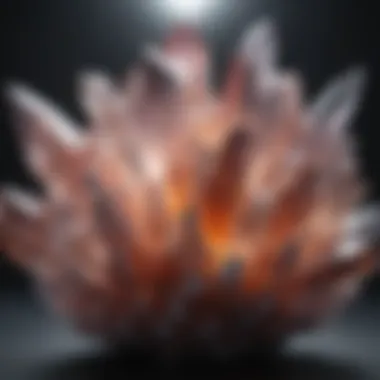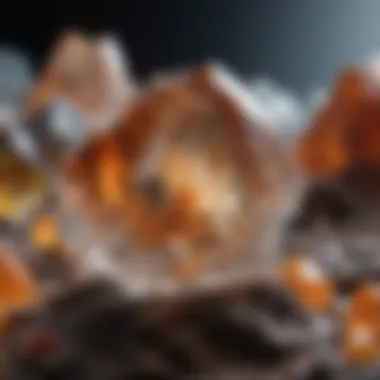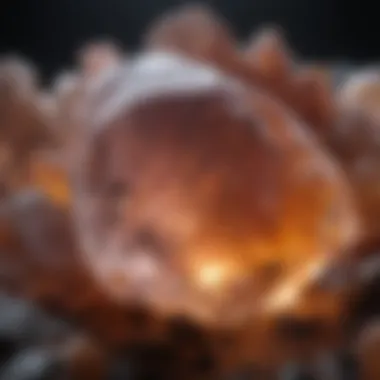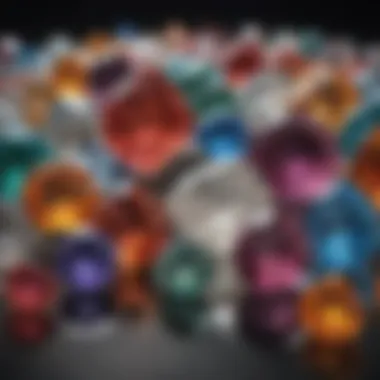Unveiling the Enigmatic Beauty of Quartz's Diverse Colors


Overview of Gemstones and Minerals
In exploring the mysteries surrounding the coloration of quartz, it is imperative to delve into the broader realm of gemstones and minerals. The history of gemstone and mineral use dates back centuries, with these precious specimens holding significant cultural and societal relevance. From adorning royalty to featuring in religious ceremonies, gemstones have always captivated human fascination through their beauty and rarity.
Gemstone Formation and Properties
The process of gemstone formation is a complex interplay of geological forces over thousands to millions of years. Gemstones are defined by unique properties such as color, hardness, and luster, factors that distinguish them from common minerals. Understanding the classification based on these characteristics provides crucial insights into the extraordinary nature of gemstones and their allure.
Types of Gemstones
Within the world of gemstones, distinctions are made between precious and semi-precious varieties, dictating their rarity and value in the market. While precious gems like diamonds and rubies command attention, semi-precious stones like amethyst and turquoise offer a diverse palette of colors and meanings. Additionally, exotic and rare gemstones bring an element of exclusivity, enticing collectors and connoisseurs with their scarcity and unparalleled beauty.
Identifying and Evaluating Gemstones
Exploring the mysteries of quartz's coloration involves understanding the factors that influence a gemstone’s value and desirability. Techniques for gemstone identification play a crucial role in distinguishing between natural and synthetic stones, safeguarding consumers from imitations. Evaluating gemstone quality requires a keen eye for detail and an appreciation for the unique characteristics that make each gemstone distinct.
Caring for Gemstones
Proper care and maintenance are essential to preserve the beauty and longevity of gemstones, including quartz. Cleaning and storing these treasures correctly help prevent wear and damage, ensuring their enduring splendor. By avoiding common mistakes in gemstone care and following preservation tips tailored to specific gem types, enthusiasts can enjoy their precious gems for years to come.
Introduction
To embark on a profound exploration of the enigmatic realm of quartz's color, one must first grasp the fundamental underpinnings that define its allure. Quartz, a mineral renowned for its vast array of stunning hues, serves as a testament to the intricate processes that mold our planet's geological landscape. This introduction sets the stage for unraveling the mysteries shrouding quartz's captivating color palette. By delving into the depths of quartz's chromatic spectrum, we aim to unveil the hidden gems of knowledge that await discovery in this fascinating journey.
Understanding Quartz


Quartz, with its remarkable composition, acts as a cornerstone in both the geological tapestry and the realm of gemology. The Composition of Quartz forms the bedrock of its allure, bearing a unique blend of silicon and oxygen molecules that imbue it with unparalleled vibrancy. This exceptional composition underpins its resilience and luster, making it a prized choice for artisans and scientists alike. The Significance of Quartz in Geology transcends mere aesthetics, playing a crucial role in understanding Earth's history and ecosystem dynamics. Its prevalence across diverse geological formations cements its status as a cornerstone mineral, enabling us to decode the Earth's ancient narrative through its crystalline structure.
Composition of Quartz
The Composition of Quartz, characterized by its silicon dioxide structure, stands as a testament to the mineral's enduring legacy. This harmonious fusion of silica molecules infuses quartz with its crystalline purity, showcasing a resilience that withstands the tests of time. The key allure of Quartz's composition lies in its versatility, allowing for multifaceted applications in both industrial and aesthetic domains. Though imperfections may arise, such as inherent inclusions or color variations, they add a unique charm to the mineral's visual appeal, turning flaws into distinctive features that captivate the discerning eye.
Significance in Geology
Within the realm of geology, Quartz emerges as a pivotal player in deciphering the Earth's ancient chronicles. Its abundance in varied rock formations serves as a reliable indicator of past environmental conditions, unveiling insights into the ever-evolving landscape of our planet. The Significance of Quartz in Geology extends beyond mere aesthetics, offering researchers a window into geological processes spanning millennia. By studying Quartz's geochemical signatures and distribution patterns, geologists unearth invaluable clues that paint a vivid picture of Earth's geological evolution.
Factors Influencing Quartz Color
In the realm of gemstones, understanding the factors influencing quartz color is imperative for gemstone enthusiasts. The allure of quartz lies not only in its physical properties but also in its mesmerizing color variations. By delving into the mechanisms behind these color variations, one can truly appreciate the depth and complexity of this fascinating gemstone. Factors such as mineral impurities, natural radiation exposure, and crystal defects play a pivotal role in shaping the unique hues of quartz.
Mineral Impurities
Iron and Aluminum in Quartz
Iron and aluminum are key players in determining the coloration of quartz. The presence of these mineral impurities can imbue quartz with a spectrum of colors ranging from vibrant blues to earthy reds. Iron, in particular, is known for creating striking color variations in quartz, while aluminum contributes to enhancing and modifying these hues. Understanding the role of iron and aluminum in quartz sheds light on the geological processes that have shaped these gemstones over millennia.
Transition Metal Ions
Transition metal ions represent another facet of mineral impurities that influence quartz coloration. These ions, from elements like titanium and manganese, introduce subtle nuances to quartz hues, creating exquisite patterns and shades. The interplay between transition metal ions and the crystalline structure of quartz results in a kaleidoscope of colors that stir the imagination. Exploring the impact of these ions on quartz color provides insights into the scientific complexity that underlies the beauty of this gemstone.
Natural Radiation Exposure
Natural radiation exposure is a fascinating factor that contributes to the coloration of quartz. The interaction of quartz with natural sources of radiation over time can alter its pigmentation, leading to a broad spectrum of colors. From delicate pastels to deep, rich tones, the effects of radiation exposure on quartz are a testament to the intricate processes that occur within the Earth's crust. Unraveling the mysteries of how natural radiation shapes quartz coloration unveils the subtle forces at play in the creation of these gemstones.


Crystal Defects
Crystal defects serve as intriguing elements that influence the color variations observed in quartz. These defects, arising from irregularities in the crystal lattice structure, can scatter light in unique ways, lending a mesmerizing quality to quartz hues. By exploring the role of crystal defects in quartz color variations, one gains a deeper appreciation for the exquisite patterns and textures found in nature. Each defect contributes to the tapestry of colors that adorn quartz crystals, showcasing the wondrous complexity of this beloved gemstone.
Varieties of Quartz Colors
Varieties of Quartz Colors holds a pivotal role in unraveling the enigmatic world of quartz hues. Within the spectrum of quartz coloration, different varieties each carry their unique characteristics and significance. Understanding the distinct nuances of these varieties is paramount for gemstone connoisseurs and enthusiasts alike. Delving into the array of Quartz Colors unveils a rich tapestry of options, each with its allure and charm. Analyzing the diverse range of colors in quartz provides a profound insight into the geological and chemical properties that contribute to their formation and aesthetics.
Clear and Transparent Quartz
Clear and Transparent Quartz, also known as Rock Crystal, is a mesmerizing variation renowned for its pristine clarity and purity. Pure Quartz Crystals within this category dazzle with their translucency and luminosity, reflecting light with a breathtaking brilliance. The flawless nature of these crystals makes them highly sought after in both the gemstone and metaphysical communities.
Pure Quartz Crystals
Pure Quartz Crystals epitomize clarity and elegance in the world of gemstones. Their pristine transparency allows them to act as amplifiers of energy, making them a popular choice for those seeking spiritual enlightenment or healing properties. The unparalleled purity of Pure Quartz Crystals lends them a timeless appeal that transcends trends and fads. In the realm of metaphysics, these crystals are valued for their ability to enhance focus, amplify intentions, and promote emotional balance.
Smoky Quartz
Smoky Quartz, with its enigmatic smoky hue, is a variety of quartz shrouded in mystery and allure. The captivating tones of Smoky Quartz evoke images of misty landscapes and ancient forests, adding a touch of mystique to any jewelry piece or decor. The origins of this distinct hue lie in the presence of natural irradiation and other geological processes.
Origin of Smoky Hue
The Origin of Smoky Hue in quartz is a result of irradiation from nearby radioactive elements present during the crystal's formation. This process imbues the quartz with its characteristic smoky color, ranging from light gray to deep charcoal. The unique blend of transparency and opacity in Smoky Quartz makes it a versatile choice for both subtle accents and statement pieces.
Rose Quartz
Rose Quartz, often hailed as the


Enhancements and Treatments
In this dynamic realm of gemology, the section on Enhancements and Treatments within the context of quartz's color spectrum emerges as a pivotal exploration. Understanding the nuances of Enhancements and Treatments offers a profound insight into the meticulous processes that can augment and refine the natural beauty of quartz. The significance lies in the ability to unlock unique color variations that may not manifest naturally, thereby expanding the possibilities for creative expression and aesthetic appeal in various industries. Delving into Enhancements and Treatments illuminates the craftsmanship and innovation involved in enhancing the inherent allure of quartz, setting the stage for a captivating narrative on transformation and artistry.
Heat Treatment
Exploring the facet of Heat Treatment in the realm of quartz delves into a process that harnesses controlled heat to induce alterations in the gemstone's color profile. The Effects on Color resulting from Heat Treatment play a pivotal role in shaping the final appearance of quartz specimens. This method, cherished for its ability to intensify or modify hues, presents a compelling avenue for gemologists and artisans to imbue quartz with specific tones or properties desired for various applications. Heat Treatment stands as a cornerstone in the enhancement journey of quartz, offering a versatile means to achieve desired aesthetic outcomes through controlled heat applications.
Irradiation
Unveiling the intricacies of Irradiation in the context of gem treatment unravels a technique that influences the color characteristics of quartz in a profound manner. The Color Modification brought about by Irradiation unveils a spectrum of transformations that cater to the diverse preferences of gem enthusiasts and industry professionals. This method, revered for its precision and ability to introduce vividness to quartz hues, serves as a strategic tool in the creation of bespoke gemstones destined for exquisite jewelry pieces and decorative accents. Navigating through the realm of Irradiation exposes the nuanced interplay between science and artistry, shaping quartz into distinctive manifestations that captivate admirers worldwide.
Practical Applications of Quartz Colors
In the intricate world of quartz hues, the Practical Applications of Quartz Colors section plays a pivotal role in unraveling the diverse facets and functionalities of this mesmerizing gemstone. Here, we delve into the significance of harnessing quartz's kaleidoscopic palette in various practical settings, ranging from jewelry design to interior decor. By exploring the versatility and aesthetic appeal of quartz colors, we shed light on how these unique variations can enhance different aspects of human life.
Jewelry Design
Delving deeper into the Practical Applications of Quartz Colors, the Jewelry Design aspect emerges as a shining gem in the realm of adornment. The Role of Color in Jewelry holds a prominent position, as it significantly influences the overall aesthetics and appeal of jewelry pieces. With a focus on the interaction between quartz hues and design concepts, we explore how colors can evoke emotions, convey meanings, and enhance the wearer's style and personality. This section highlights the importance of selecting the right quartz colors to create captivating and impactful jewelry pieces that resonate with diverse audiences.
Interior écor
Within the domain of Practical Applications of Quartz Colors, the Interior Décor segment opens a door to a world of design possibilities and aesthetic enhancement. Utilizing Quartz Variations in interior decor involves understanding how different colors and textures of quartz can transform living spaces into stylish sanctuaries. By leveraging the visual charm and metaphysical properties of quartz, interior designers can create spaces that exude elegance, tranquility, and unique character. This section explores the advantages of incorporating quartz colors in decor schemes, from countertops to accent pieces, illustrating how these natural elements can elevate the ambiance and visual appeal of any environment.
Conclusion
In delving deeper into the mysteries of Quartz's color, we unravel a world of fascinating intricacies that go beyond surface beauty. The importance of the Conclusion section lies in its ability to synthesize the vast array of information presented throughout this article. By reflecting on the key points discussed – from the geological processes shaping Quartz hues to the scientific insights behind its pigmentation – we can appreciate the kaleidoscopic spectrum of Quartz coloration in its entirety. This section offers a final narrative thread that ties together the various aspects explored, leaving the reader with a profound understanding of the captivating world of Quartz colors.
Appreciating the Diversity of Quartz Colors
Final Thoughts
When contemplating the final thoughts on the diversity of Quartz colors, one cannot help but be consumed by the sheer magnificence that this gemstone embodies. The specific aspect of 'Final Thoughts' contributes significantly to the overarching theme of this article, offering a reflective lens through which we can view the expansive range of Quartz hues. What sets 'Final Thoughts' apart is its ability to encapsulate the essence of Quartz colors in a concise yet impactful manner. This choice enriches the article by providing readers with a conclusive perspective on the diverse manifestations of Quartz coloration. The unique feature of 'Final Thoughts' lies in its ability to provoke contemplation and appreciation for the natural beauty that Quartz exudes. While it may present limitations in terms of exhaustive detail, its highlight on the broader significance of Quartz colors within this article ensures a well-rounded exploration that resonates with audiences seeking a profound understanding of this mesmerizing gemstone.







